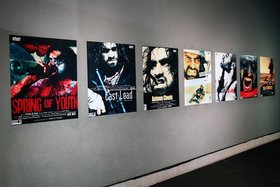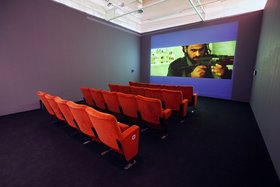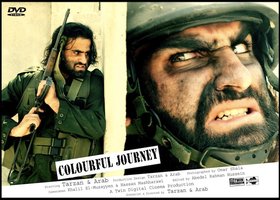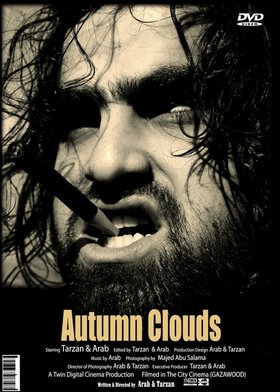Interviews
Colourful Shadows and Reel Journeys
Tarzan and Arab in conversation with Laura Allsop
Tarzan and Arab (real names Ahmad and Mohammad Abu Nasser) were born in Gaza in 1988, a year after the last cinemas in Gaza were closed. Long-time cinephiles, the identical twin brothers, who still live in Gaza, developed their passion for cinema with the help of Palestinian filmmaker Khalil Al Mozian. Since winning the AM Qattan Foundation's Young Artist of the Year Award in 2010 with a series of posters for fictional feature films named after Israeli Defence Force (IDF) military campaigns entitled Gazawood and a short film Colourful Journey (2010), they have had their work shown in London, Austin, and currently in Manchester at the Cornerhouse Gallery. Ibraaz's Laura Allsop speaks to the brothers about their love of cinema, the difficulties they encountered while filming and the first time they saw their own film screened in a cinema theatre.
Laura Allsop: Can you tell me where the names Tarzan and Arab came from? Were they chosen for their cinematic overtones?
Tarzan and Arab: Tarzan and Arab are our childhood nicknames. Our grandfather gave us them when we were born. I am not too sure why but we loved it, to the extent that when someone called us by our real names – Mohammad (Arab) and Ahmad (Tarzan) – we would not respond. We chose these to be our stage names. Little did we know that with the success of our film, they would stick.
LA: You have a life-long passion for cinema. How did you nurture that passion living in Gaza, where there hasn't been a cinema since the late 1980s? How, for example, do you get hold of films, equipment with which to film and edit, and so on?
T&A: Gaza has had cinema theatres since 1944 and these remained in Gaza until the 1980s. But in 1988, the year of our birth, cinemas were shut down. We longed for a TV since we were young children; we worshiped anything that had film or a picture. Growing up, we were shocked that there were no cinema theatres. We remember skipping our studies to explore burned-down cinemas not far from our home. They were always demolished and didn't have any doors; we would jump over three-metre-high gates to get in and then we would sit and look at the remaining burned posters that had managed to survive, the big screen and the theatre itself. I remember wishing that I could take out a part of the wall that had a film poster on it, but I didn't because it was damaged. I remember we always had this dream, that there would come a day when our posters would be hanging on the walls and our movies would be screened in cinema theatres.
The absence of film and cinema theatres magnified our hopelessness; however, we did not let this get us down. We used to search for old and new movie posters, for films that were not available on TV, films that people did not know by Tarkovsky, Fellini, Bergman, De Sica, Kieslowski and many others. Their films had an internal effect on the person rather than being just an external phenomenon. We continuously searched for books, journals and information on film and cinema. We sought out any individuals from Gaza who had any association with cinema, the most known being our respected filmmaker Khalil Al Mozian. All of this contributed to enriching us with the culture of cinema and will continue to help us in the future.
LA: You found a mentor in Al Mozian – can you tell me about how your relationship developed?
T&A: Khalil is one of the most famous directors in Gaza, who obtained a degree in filmmaking from the academy of Saint Petersburg. Our relationship with him began in 2005, when we spent time with the artist Dr. Shafiq Radwan, who would look at and critique our amateur photographs. Shafiq was surprised by these pictures, and so he said he would speak to the most famous director in Gaza and that he would arrange for us to visit him the next day. He actually did call him and he said there are two amazing caricaturists that will give you a hand. And so we visited him, and I remember that he looked at us and could not believe that we were two people from Gaza. We showed him our photos and it was from that day that we were completely infatuated with him, and our relationship began. Finally, we found a mentor who was willing to help us enter the film industry. He shared with us his knowledge of film and cinema and would never hold back any information from us. He gave us any films that he had and discussed them with us and had hopes that we would one day be two real directors. He gave us the opportunity to work with him and from it, we have gained so much experience. His dream was to be sitting at the back of a movie theatre smoking and watching a quality film of our own production. We have now established a simple company called Lama Films Cinema Production. Our relationship is stronger than that of a brother and brother, of father and son, of teacher and student. We are with one another from 8am till 10pm every day.
LA: You have described Gaza in interviews as a natural film set – how did you go about filming your work Colourful Journey, which is currently being screened at Cornerhouse Gallery in Manchester? And how did you get around the logistical problems of filming in Gaza?
T&A: It was through the AM Qattan Foundation's Young Artist of the Year Award, 2010. The project was to convert 20 Israeli army operations into film posters in the form of a project called Gazawood and the creation of one of these posters into a short film. Our idea was to discuss the Israeli Army operations from a filmic perspective, and so we chose the operation 'Colourful Journey' and portrayed it through the context of the current Palestinian situation. I discussed it with Khalil, who liked this idea a lot. As we did not have the expertise to carry out the production of this film, we told Khalil that we would appreciate it if he would film with us, as he knew exactly what we would have wanted. Our expertise was only in creating pictures with the knowledge of several other things, so he advised us to draw our idea up via a story board. We then faced many obstacles – the lack of filming equipment, high costs, as well as finding demolished locations suitable as a set.
We soon found the ideal location by the sea but it was shortly filled with Israeli naval ships looking out for anyone with armed weapons [the film features two armed protagonists]. Hence, we had to change location, causing us to lose a day of filming as well as rental money for the camera we were using. Other major obstacles included the highly political process of obtaining a filming warrant. The reason for the delay in filming was due to getting approval from the Islamic government, who was not keen on our appearances. However, we were motivated, even if it was at the risk of paying the price with our own lives. We wanted to create a film, we wanted to create a dream, and this determination is what made this film a success – without of course forgetting the support we received from Khalil Al Mozian.
We hope that the Cornerhouse exhibition will bring people's attention to the film and we hope that we have created a piece that portrays the Palestinian situation in an artistic manner that will reach the hearts of viewers. For art as a weapon is stronger than heavy artillery. And art is the language that is closest to our hearts.
LA: Are you planning on making an extended version of Colourful Journey?
T&A: Our next upcoming project, which we will finish writing in the coming days, is actually a new film called The Last Wash. It's a love story about an ugly man named Yaqoub, whose job is to wash corpses before burial; it is a job that is considered unacceptable in society. He has been in love with a woman named Sara since childhood; the two grew up together, with him keeping his love a secret. All she knew of him was that he was an ugly man with an unsavoury job. But Sara is in love with another man, who loves her only for her body. He is constantly coming to ask for her hand in marriage. On the one hand, a conflict occurs between Yaqoub, his sister and her husband, who wishes to marry him to his ugly, older sister. And on the other hand, it is about a conflict between Sara and the man who wants to marry her. One day Yaqoub witnesses Sara sitting on the man's lap, which shocks him to the extent that he is driven to murder. After a couple of days, Yaqoub is called upon to wash this man's corpse. He refuses to do this. In the end, Yaqoub is certain that no one will wash him when he is dead, not even Sara, and so he decides to set himself alight in order to erase any trace of his existence. We are looking for a sponsor for this production, even though it is known that production is the most difficult problem that directors in Gaza face.
LA: Is it your hope that your Gazawood production company will continue developing as a narrative in the sense that the films that are up till now 'fictional' will one day become reality?
T&A: Just as Hollywood is the site of American filmmaking and Bollywood that of India, so we hope that 'Gazawood' will now be Gaza's filmmaking home. This is our dream, and it is the name of the media production company that we founded in 2003. It is located on the roof of our house, which we sometimes use as a location for shooting photography. It soon turned into the place where we would set our movie posters. We therefore decided to launch this name in our first significant film project, and it has remained. 'Lama' is our private production company, consisting of me, my brother and Khalil. The name 'The Lama Trio' derives from Ibrahim and Badra Lama, two Palestinians who respectively directed and starred in the 1928 film Kiss in the Desert.
LA: Do you hope that by fulfilling this project, you will be building an archive?
T&A: It is certain that everything we have done, everything that has been written, or every individual that has spoken about us or any works that we've done since the beginning till now, will function one day as our archive. It will be a timeline of how we have developed as filmmakers, and every day we are benefiting and developing. We can now speak with more certainty and we have gained maturity in some areas that we were once weaker in. Tomorrow we will mature even more. A person spends his life improving their craft.
LA: You travelled to Austin recently, which was the first time either of you had left Gaza. Can you tell me about this experience, particularly seeing your own work screened in public?
T&A: It is only natural that every person will visit a place other than his own country, not with the intention of settlement but rather with the intention of learning about a different culture and experience new things. Gaza is a region of conflict, war and siege, and is unstable. We were born there and our whole lives we would dream of travel, not because we hated Gaza but because we wanted to get to know other cultures and to learn about other places, and the most important was Hollywood. We remember that whenever we spoke to anyone we would link the conversation to Hollywood, and they would laugh at us. We had two opportunities to travel before visiting America, which we missed out on. The first was to Norway and the second to the UK, to attend our exhibition at The Mosaic Rooms in London; despite missing these, we always knew it was for the best. But this trip to America came as a surprise. We were invited by the Alamo Drafthouse Cinema, in Austin, Texas. Initially, we didn't think it would happen, because it was America. But we decided to go through with it, even if was to cost us everything. Their idea of screening our film in the oldest theatre in Texas was enticing to us. This would be the first time we would enter a cinema theatre and the first movie we would watch inside a cinema would be our own. This had such a potent effect on us that it allowed us to overcome any obstacles that would come our way.
At the beginning of this matter we faced great difficulties. An interview was to be conducted at the American Embassy, which is situated in Jerusalem. We had tried to get there but this was very difficult. So we decided to take the interview in the embassy in Egypt. The Egyptian borders only accept a certain amount of travellers per day, so it was necessary that we should book. We did not have an official excuse to leave Gaza, so we applied for a visa to get to Tunisia. After three weeks, we were able to leave Gaza but with much difficulty, and after investigations on both the Palestinian and Egyptian borders, due to the 'oddness' of our characters, we were finally able to enter Egypt with the will of God. We suffered the same problems in Egypt, as people were disturbed by our unusual appearances [the duo have long hair, and wear smuggled Converse trainers and other more recognizable western styles]. What saved us was our speaking broken Arabic, which marked us out as foreigners.
After spending a week in Egypt, we were able to book an interview at the American embassy. We took the courage to go ahead with the interview and we succeeded. We were to receive our passports after two days. However, our passports remained in the embassy for about a month and a half, and we had no proof of other identity with us. We moved around Egypt with caution, especially due to the political instability at the time (2011), with the revolution and the lack of security. But whenever we thought about going to the land of cinema we forgot about all these difficulties. We changed residency more than 13 times, each time we needed proof of identity that we did not have. In the end, and after all these difficulties and with the intervention of lawyers from Texas and a Congressman who had spoken to the embassy to convince them to give us our passports, we were finally able to leave Egypt and go to the country of movies – America.
After changeovers at four airports, and spending three nights in the air without any sleep, we finally got to Texas. What shocked us about America is that everything is so organized and the scenery is so beautiful. We had always been infatuated with Texas, ever since watching our first Westerns, and we were greeted by Tim League and the rest of the Drafthouse Cinema family – and they were in fact just like our own family in Gaza.
After spending a week in Texas, it was finally the crucial day. This was the day we had dreamed of, this was the day we were to enter into the cinema and breathe the air enriched by the likes of Charlie Chaplin, Marilyn Monroe, Robert de Niro and Anthony Quinn. It was an air filled with the scent of film negatives, classical movies, modern movies – feelings we do not know how to express. We could not believe the way the audience and fans in Texas were so receptive to us. The hall was completely filled: we spoke of life, the message of Islam that we wished to share and spread to the world, we spoke of the beauty that God had created and which we should enjoy. We spoke of the violence that we created; we spoke of Gaza and its spiritual beauty, we spoke of the constraints of cinema. We watched our film and spoke about it and the difficulties of its production. We also watched Ingmar Bergman's Cries and Whispers, which was one of the five films that we had chosen to have screened.
The question that seemed to be preoccupying people in the audience was, were we actually from Gaza? Is there anything like this in Gaza? How did we acquire this particular culture? And how were we able to obtain these films? After this success, we finally went to Hollywood. There we attended different exhibitions. But after being away from Gaza for five months, we were itching to get back and begin working on our next film – to work our way up the ladder.
LA: Do you envisage leaving Gaza again in future and how likely is this?
T&A: It is natural that we will leave Gaza again but not with the intention of permanent settlement, rather it will be to create something for the sake of Gaza or perhaps even for the purposes of studying film or filming a movie out of Gaza. But Gaza is our beloved home and the place that has aided us in our success. It is a place where everything is simple, as we ourselves are constantly searching for simplicity.
Tarzan and Arab (Ahmad and Mohammad Abu Nasser) are twin brothers born in Gaza in 1988. They studied painting at the Faculty of Fine Arts at Al Aqsa University in Gaza, and have exhibited their work in various exhibitions all over Palestine, in the 'ArtSawa Creative' Palestinian Art exhibition in Dubai in 2010, in London's Mosaic Rooms in 2011, at the Alamo Drafthouse Cinema in Austin, Texas, in 2011, and at Cornerhouse, Manchester in 2012. They are currently working on their second film.









